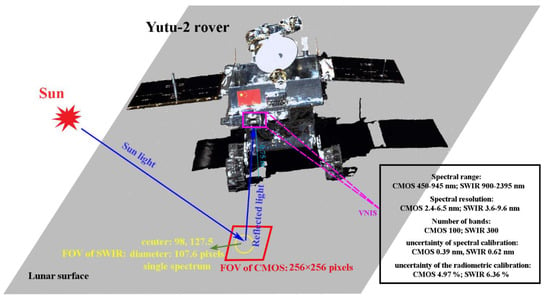Estimation of Noise in the In Situ Hyperspectral Data Acquired by Chang’E-4 and Its Effects on Spectral Analysis of Regolith
Abstract
1. Introduction
2. Data and Methods
2.1. Chang’E-4 Spectral Data and Preprocessing
2.2. Estimation of Signal–Noise Ratio
2.3. Estimation of Band Center and Depth
2.4. Estimation of Mineral Abundance
2.4.1. The Hapke Equations
2.4.2. Single-Scattering Albedo of Mineral Endmember
2.5. Estimation of SMFe Abundance
3. Results and Discussion
3.1. SNR of CMOS Image and Spectral Difference
3.2. Effects of Noise on Band Center and Depth
3.3. Effects of Noise on Estimations of Compositions
4. Conclusions
Author Contributions
Funding
Acknowledgments
Conflicts of Interest
References
- Pieters, C.M.; Boardman, J.; Buratti, B.; Chatterjee, A.; Clark, R.; Glavich, T.; Green, R.; Head, J., III; Isaacson, P.; Malaret, E. The Moon Mineralogy Mapper (M³) on Chandrayaan-1. Curr. Sci. 2009, 96, 500–505. [Google Scholar]
- Wu, Y.Z.; Zheng, Y.C.; Zou, Y.L.; Chen, J.; Xu, X.S.; Tang, Z.S.; Xu, A.A.; Yan, B.K.; Gan, F.P.; Zhang, X. A preliminary experience in the use of Chang’E-1 IIM data. Planet. Space Sci. 2010, 58, 1922–1931. [Google Scholar] [CrossRef]
- Yamamoto, S.; Matsunaga, T.; Ogawa, Y.; Nakamura, R.; Yokota, Y.; Ohtake, M.; Haruyama, J.; Morota, T.; Honda, C.; Hiroi, T.; et al. Calibration of NIR 2 of Spectral Profiler Onboard Kaguya/SELENE. IEEE Trans. Geosci. Remote Sens. 2014, 52, 6882–6898. [Google Scholar] [CrossRef]
- Clark, R.N.; Roush, T.L. Reflectance Spectroscopy―Quantitative-Analysis Techniques for Remote-Sensing Applications. J. Geophys. Res. 1984, 89, 6329–6340. [Google Scholar] [CrossRef]
- Hapke, B. Bidirectional reflectance spectroscopy: 1. Theory. J. Geophys. Res. Solid Earth 1981, 86, 3039–3054. [Google Scholar] [CrossRef]
- Pieters, C.M.; Taylor, L.A.; Noble, S.K.; Keller, L.P.; Hapke, B.; Morris, R.V.; Allen, C.C.; McKay, D.S.; Wentworth, S. Space weathering on airless bodies: Resolving a mystery with lunar samples. Meteorit. Planet. Sci. 2000, 35, 1101–1107. [Google Scholar] [CrossRef]
- Johnson, J.R.; Shepard, M.K.; Grundy, W.M.; Paige, D.A.; Foote, E.J. Spectrogoniometry and modeling of martian and lunar analog samples and Apollo soils. Icarus 2013, 223, 383–406. [Google Scholar] [CrossRef]
- Taylor, L.A.; Pieters, C.M.; Keller, L.P.; Morris, R.V.; McKay, D.S. Lunar Mare Soils: Space weathering and the major effects of surface-correlated nanophase Fe. J. Geophys. Res. Planets 2001, 106, 27985–27999. [Google Scholar] [CrossRef]
- Lin, H.; He, Z.; Yang, W.; Lin, Y.; Xu, R.; Zhang, C.; Zhu, M.-H.; Chang, R.; Zhang, J.; Li, C. Olivine-norite rock detected by the lunar rover Yutu-2 likely crystallized from the SPA impact melt pool. Natl. Sci. Rev. 2019. [Google Scholar] [CrossRef]
- Lin, H.; Xu, R.; Yang, W.; Lin, Y.; Wei, Y.; Hu, S.; He, Z.; Qiao, L.; Wan, W. In situ photometric experiment of lunar regolith with visible and near-infrared imaging spectrometer onboard the Yutu-2 lunar rover. J. Geophys. Res. Planets 2020, 125, e2019JE006076. [Google Scholar] [CrossRef]
- Hu, X.; Ma, P.; Yang, Y.; Zhu, M.H.; Jiang, T.; Lucey, P.G.; Sun, L.; Zhang, H.; Li, C.; Xu, R. Mineral Abundances Inferred From In Situ Reflectance Measurements of Chang’E-4 Landing Site in South Pole-Aitken Basin. Geophys. Res. Lett. 2019, 46, 9439–9447. [Google Scholar] [CrossRef]
- Li, C.L.; Liu, D.W.; Liu, B.; Ren, X.; Liu, J.J.; He, Z.P.; Zuo, W.; Zeng, X.G.; Xu, R.; Tan, X.; et al. Chang’E-4 initial spectroscopic identification of lunar far-side mantle-derived materials. Nature 2019, 569, 378–382. [Google Scholar] [CrossRef] [PubMed]
- Gou, S.; Di, K.; Yue, Z.; Liu, Z.; He, Z.; Xu, R.; Lin, H.; Liu, B.; Peng, M.; Wan, W. Lunar deep materials observed by Chang’e-4 rover. Earth Planet. Sci. Lett. 2019, 528, 115829. [Google Scholar] [CrossRef]
- Rasti, B.; Scheunders, P.; Ghamisi, P.; Licciardi, G.; Chanussot, J. Noise Reduction in Hyperspectral Imagery: Overview and Application. Remote Sens. 2018, 10, 482. [Google Scholar] [CrossRef]
- Horgan, B.H.N.; Cloutis, E.A.; Mann, P.; Bell, J.F. Near-infrared spectra of ferrous mineral mixtures and methods for their identification in planetary surface spectra. Icarus 2014, 234, 132–154. [Google Scholar] [CrossRef]
- Wu, Y.; Hapke, B. Spectroscopic observations of the Moon at the lunar surface. Earth Planet. Sci. Lett. 2018, 484, 145–153. [Google Scholar] [CrossRef]
- Moriarty, D.; Pieters, C.; Isaacson, P. Compositional heterogeneity of central peaks within the South Pole-Aitken Basin. J. Geophys. Res. Planets 2013, 118, 2310–2322. [Google Scholar] [CrossRef]
- Moriarty, D.P.; Pieters, C.M. The Character of South Pole-Aitken Basin: Patterns of Surface and Subsurface Composition. J. Geophys. Res. Planets 2018, 123, 729–747. [Google Scholar] [CrossRef]
- Adams, J.B. Visible and near-infrared diffuse reflectance spectra of pyroxenes as applied to remote sensing of solid objects in the solar system. J. Geophys. Res. 1974, 79, 4829–4836. [Google Scholar] [CrossRef]
- Klima, R.L.; Dyar, M.D.; Pieters, C.M. Near-infrared spectra of clinopyroxenes: Effects of calcium content and crystal structure. Meteorit. Planet. Sci. 2011, 46, 379–395. [Google Scholar] [CrossRef]
- Sunshine, J.M.; Pieters, C.M. Determining the composition of olivine from reflectance spectroscopy. J. Geophys. Res. Planets 1998, 103, 13675–13688. [Google Scholar] [CrossRef]
- Li, S.A.; Li, L. Radiative transfer modeling for quantifying lunar surface minerals, particle size, and submicroscopic metallic Fe. J. Geophys. Res. Planets 2011, 116. [Google Scholar] [CrossRef]
- Denevi, B.W.; Lucey, P.G.; Sherman, S.B. Radiative transfer modeling of near-infrared spectra of lunar mare soils: Theory and measurement. J. Geophys. Res. Planets 2008, 113. [Google Scholar] [CrossRef]
- Zhang, H.; Yang, Y.Z.; Yuan, Y.; Jin, W.D.; Lucey, P.G.; Zhu, M.H.; Kaydash, V.G.; Shkuratov, Y.G.; Di, K.C.; Wan, W.H.; et al. In situ optical measurements of Chang’E-3 landing site in Mare Imbrium: 1. Mineral abundances inferred from spectral reflectance. Geophys. Res. Lett. 2015, 42, 6945–6950. [Google Scholar] [CrossRef]
- Hapke, B. Space weathering from Mercury to the asteroid belt. J. Geophys. Res. Planets 2001, 106, 10039–10073. [Google Scholar] [CrossRef]
- Pieters, C.M.; Noble, S.K. Space weathering on airless bodies. J. Geophys. Res. Planets 2016, 121, 1865–1884. [Google Scholar] [CrossRef]
- Wang, Z.; Wu, Y.; Blewett, D.T.; Cloutis, E.A.; Zheng, Y.; Chen, J. Submicroscopic metallic iron in lunar soils estimated from the in situ spectra of the Chang’E-3 mission. Geophys. Res. Lett. 2017, 44, 3485–3492. [Google Scholar] [CrossRef]
- Gou, S.; Yue, Z.Y.; Di, K.C.; Wan, W.H.; Liu, Z.Q.; Liu, B.; Peng, M.; Wang, Y.X.; He, Z.P.; Xu, R. In situ spectral measurements of space weathering by Chang’e-4 rover. Earth Planet. Sci. Lett. 2020, 536. [Google Scholar] [CrossRef]
- Lucey, P.G.; Noble, S.K. Experimental test of a radiative transfer model of the optical effects of space weathering. Icarus 2008, 197, 348–353. [Google Scholar] [CrossRef]
- Li, C.; Xu, R.; Lv, G.; Yuan, L.; He, Z.; Wang, J. Detection and calibration characteristics of the visible and near-infrared imaging spectrometer in the Chang’e-4. Rev. Sci. Instrum. 2019, 90, 103106. [Google Scholar] [CrossRef]
- He, Z.; Li, C.; Xu, R.; Lv, G.; Yuan, L.; Wang, J. Spectrometers based on acousto-optic tunable filters for in-situ lunar surface measurement. J. Appl. Remote Sens. 2019, 13, 027502. [Google Scholar]
- Gueymard, C.A. The sun’s total and spectral irradiance for solar energy applications and solar radiation models. Sol. Energy 2004, 76, 423–453. [Google Scholar] [CrossRef]
- He, Z.P.; Wang, B.Y.; Lu, G.; Li, C.L.; Yuan, L.Y.; Xu, R.; Liu, B.; Chen, K.; Wang, J.Y. Operating principles and detection characteristics of the Visible and Near-Infrared Imaging Spectrometer in the Chang’e-3. Res. Astron. Astrophys. 2014, 14, 1567–1577. [Google Scholar] [CrossRef]
- Li, C.L.; Wang, Z.D.; Xu, R.; Lv, G.; Yuan, L.Y.; He, Z.P.; Wang, J.Y. The Scientific Information Model of Chang’e-4 Visible and Near-IR Imaging Spectrometer (VNIS) and In-Flight Verification. Sensors 2019, 19, 482. [Google Scholar] [CrossRef]
- Gao, L.; Wen, J.; Ran, Q. Residual-Scaled Local Standard Deviations Method for Estimating Noise in Hyperspectral Images. In Proceedings of the MIPPR 2007: Multispectral Image Processing, Wuhan, China, 15–17 November 2007; p. 678713. [Google Scholar]
- Van der Meer, F.D.; De Jong, S.M. Imaging Spectrometry: Basic Principles and Prospective Applications; Springer: Berlin/Heidelberg, Germany, 2011. [Google Scholar]
- Corner, B.R.; Narayanan, R.M.; Reichenbach, S.E. Noise estimation in remote sensing imagery using data masking. Int. J. Remote Sens. 2003, 24, 689–702. [Google Scholar] [CrossRef]
- Gao, B.C. An Operational Method for Estimating Signal to Noise Ratios from Data Acquired with Imaging Spectrometers. Remote Sens. Environ. 1993, 43, 23–33. [Google Scholar] [CrossRef]
- Xia, Z.; Tong, S.; Dong, Z. Assessment of the information quality of hyperspectral data from interference imaging spectrometer. J. Infrared Millim. Waves 2012, 31, 143–147. [Google Scholar]
- Savitzky, A.; Golay, M.J.E. Smoothing + Differentiation of Data by Simplified Least Squares Procedures. Anal. Chem. 1964, 36, 1627–1639. [Google Scholar] [CrossRef]
- Yang, Y.; Lin, H.; Liu, Y.; Lin, Y.; Wei, Y.; Hu, S.; Yang, W.; Xu, R.; He, Z.; Zou, Y. The effects of viewing geometry on the spectral analysis of lunar regolith as inferred by in situ spectrophotometric measurements of Chang’E-4. Geophys. Res. Lett. 2020, 47, e2020GL087080. [Google Scholar] [CrossRef]
- Isaacson, P.J.; Sarbadhikari, A.B.; Pieters, C.M.; Klima, R.L.; Hiroi, T.; Liu, Y.; Taylor, L.A. The lunar rock and mineral characterization consortium: Deconstruction and integrated mineralogical, petrologic, and spectroscopic analyses of mare basalts. Meteorit. Planet. Sci. 2011, 46, 228–251. [Google Scholar] [CrossRef]
- Iordache, M.D.; Bioucas-Dias, J.M.; Plaza, A. Sparse Unmixing of Hyperspectral Data. IEEE Trans. Geosci. Remote Sens. 2011, 49, 2014–2039. [Google Scholar] [CrossRef]
- Lin, H.L.; Mustard, J.F.; Zhang, X. A methodology for quantitative analysis of hydrated minerals on Mars with large endmember library using CRISM near-infrared data. Planet. Space Sci. 2019, 165, 124–136. [Google Scholar] [CrossRef]
- Lin, H.L.; Zhang, X. Retrieving the hydrous minerals on Mars by sparse unmixing and the Hapke model using MRO/CRISM data. Icarus 2017, 288, 160–171. [Google Scholar] [CrossRef]
- Lin, H.L.; Zhang, X.; Shuai, T.; Zhang, L.F.; Sun, Y.L. Abundance retrieval of hydrous minerals around the Mars Science Laboratory landing site in Gale crater, Mars. Planet. Space Sci. 2016, 121, 76–82. [Google Scholar] [CrossRef]
- Huang, J.; Xiao, Z.Y.; Flahaut, J.; Martinot, M.; Head, J.; Xiao, X.; Xie, M.G.; Xiao, L. Geological Characteristics of Von Karman Crater, Northwestern South pole-Aitken Basin: Chang’E-4 Landing Site Region. J. Geophys. Res. Planets 2018, 123, 1684–1700. [Google Scholar] [CrossRef]
- Pieters, C.; Shkuratov, Y.; Kaydash, V.; Stankevich, D.; Taylor, L. Lunar soil characterization consortium analyses: Pyroxene and maturity estimates derived from Clementine image data. Icarus 2006, 184, 83–101. [Google Scholar] [CrossRef]
- Lucey, P.G.; Blewett, D.T.; Jolliff, B.L. Lunar iron and titanium abundance algorithms based on final processing of Clementine ultraviolet-visible images. J. Geophys. Res. Planets 2000, 105, 20297–20305. [Google Scholar] [CrossRef]
- Lucey, P.G.; Blewett, D.T.; Taylor, G.J.; Hawke, B.R. Imaging of lunar surface maturity. J. Geophys. Res. Planets 2000, 105, 20377–20386. [Google Scholar] [CrossRef]
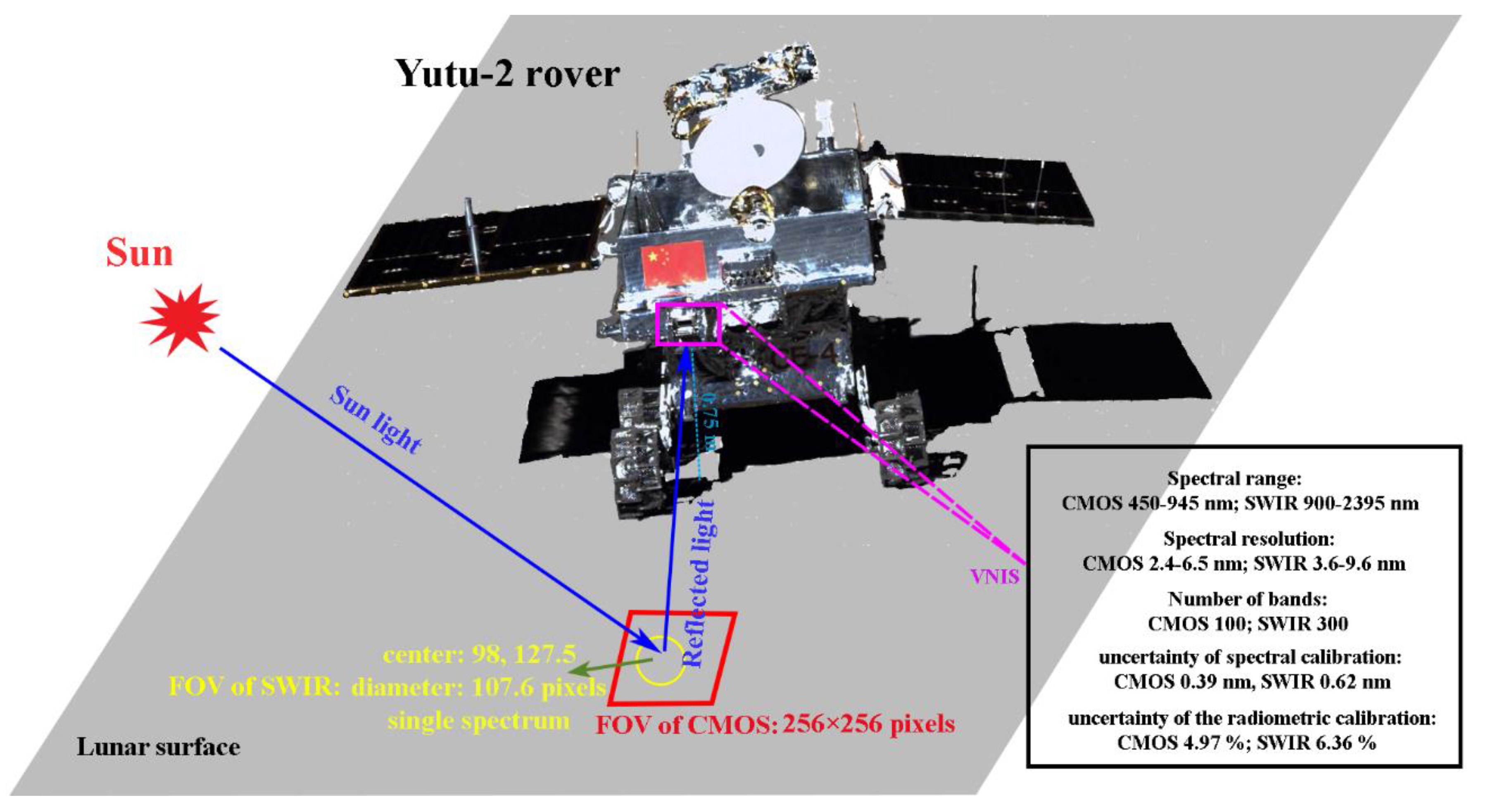
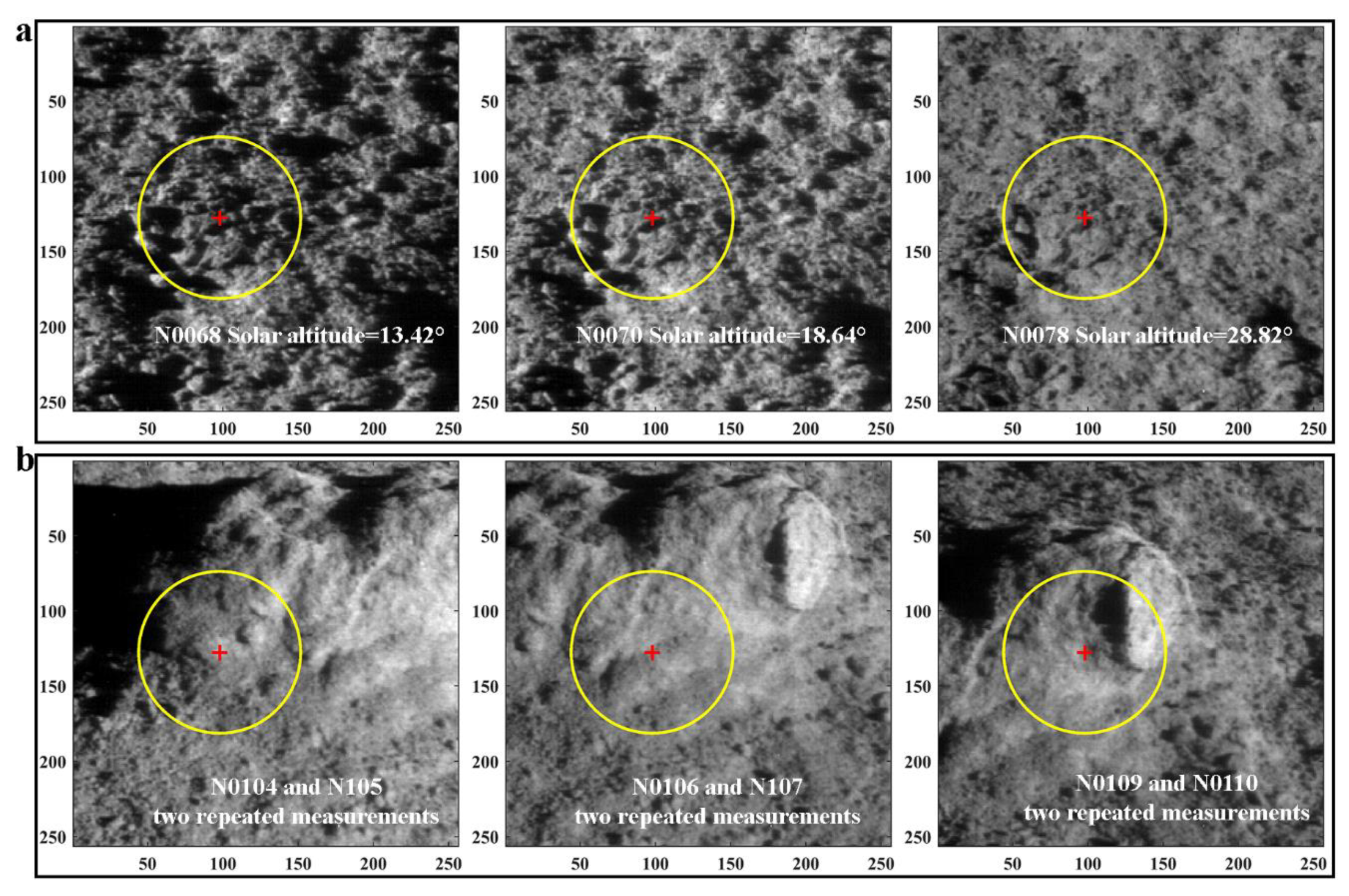
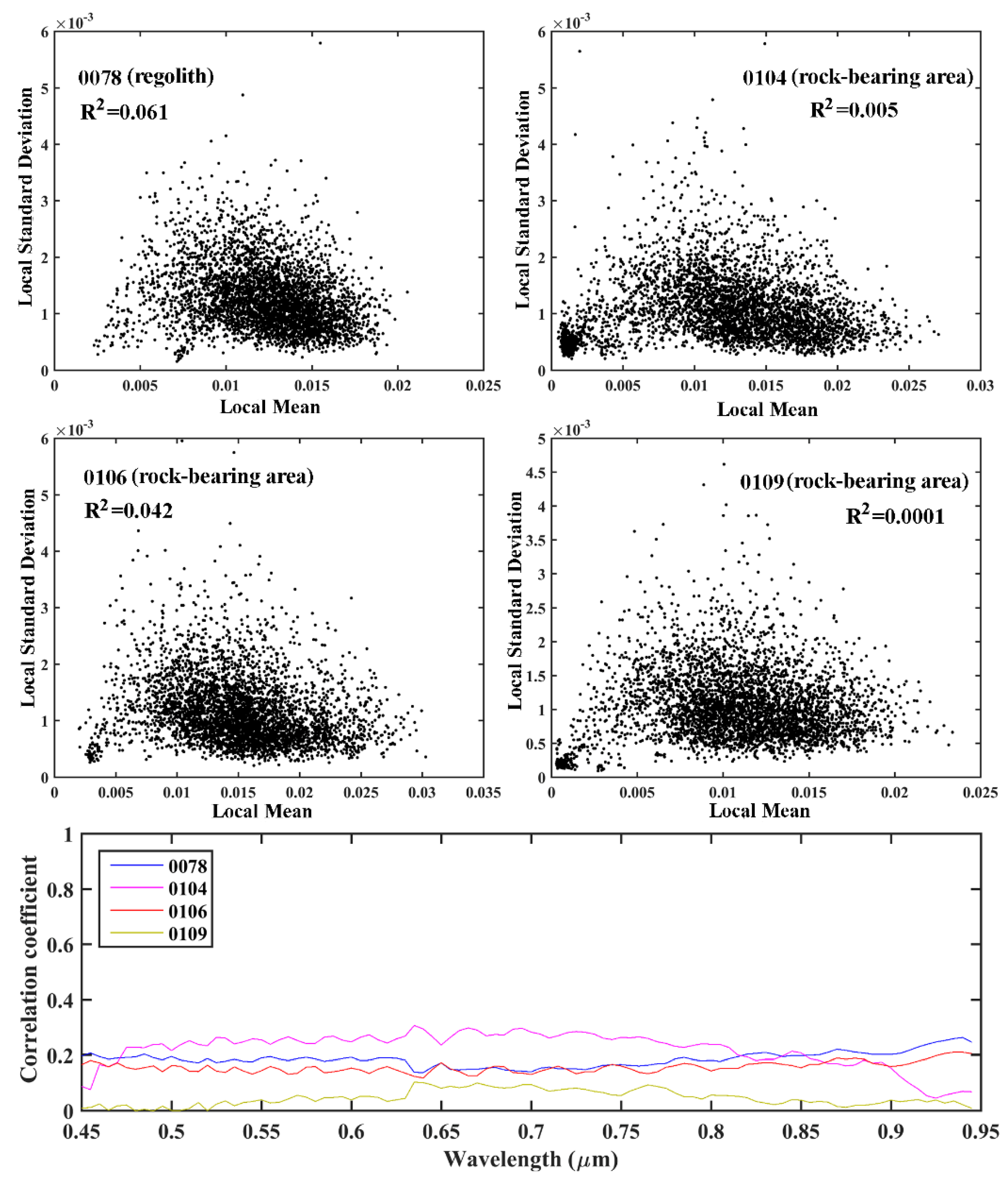

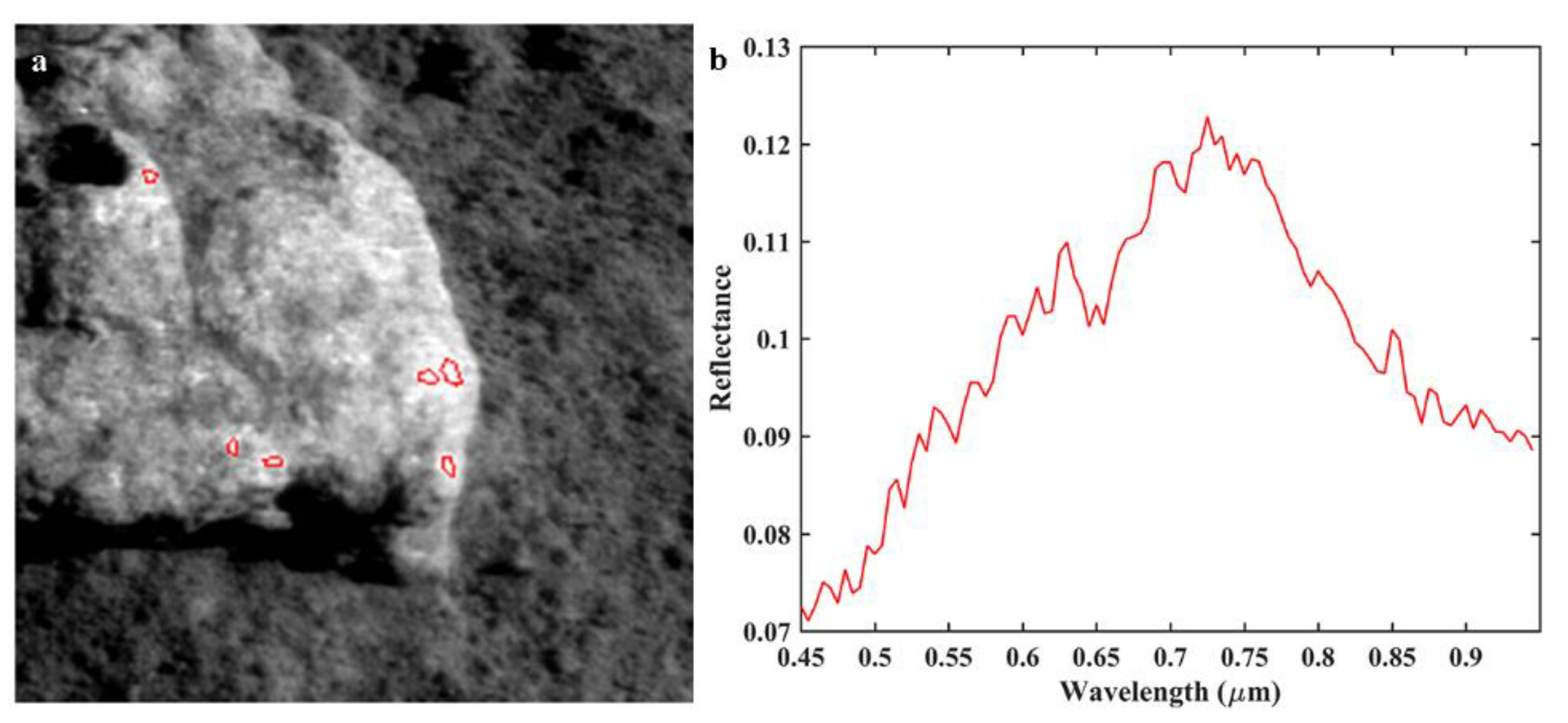
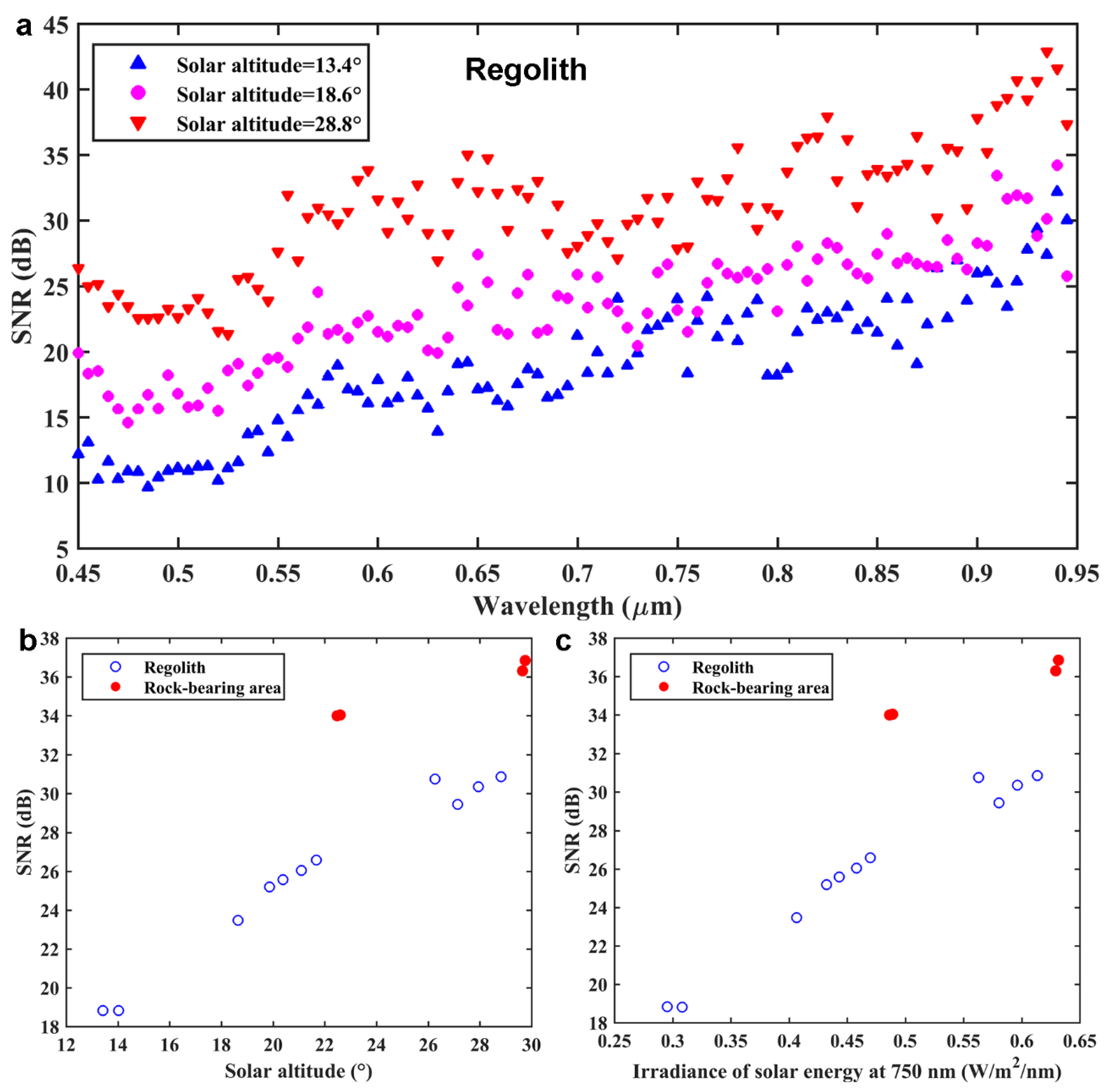
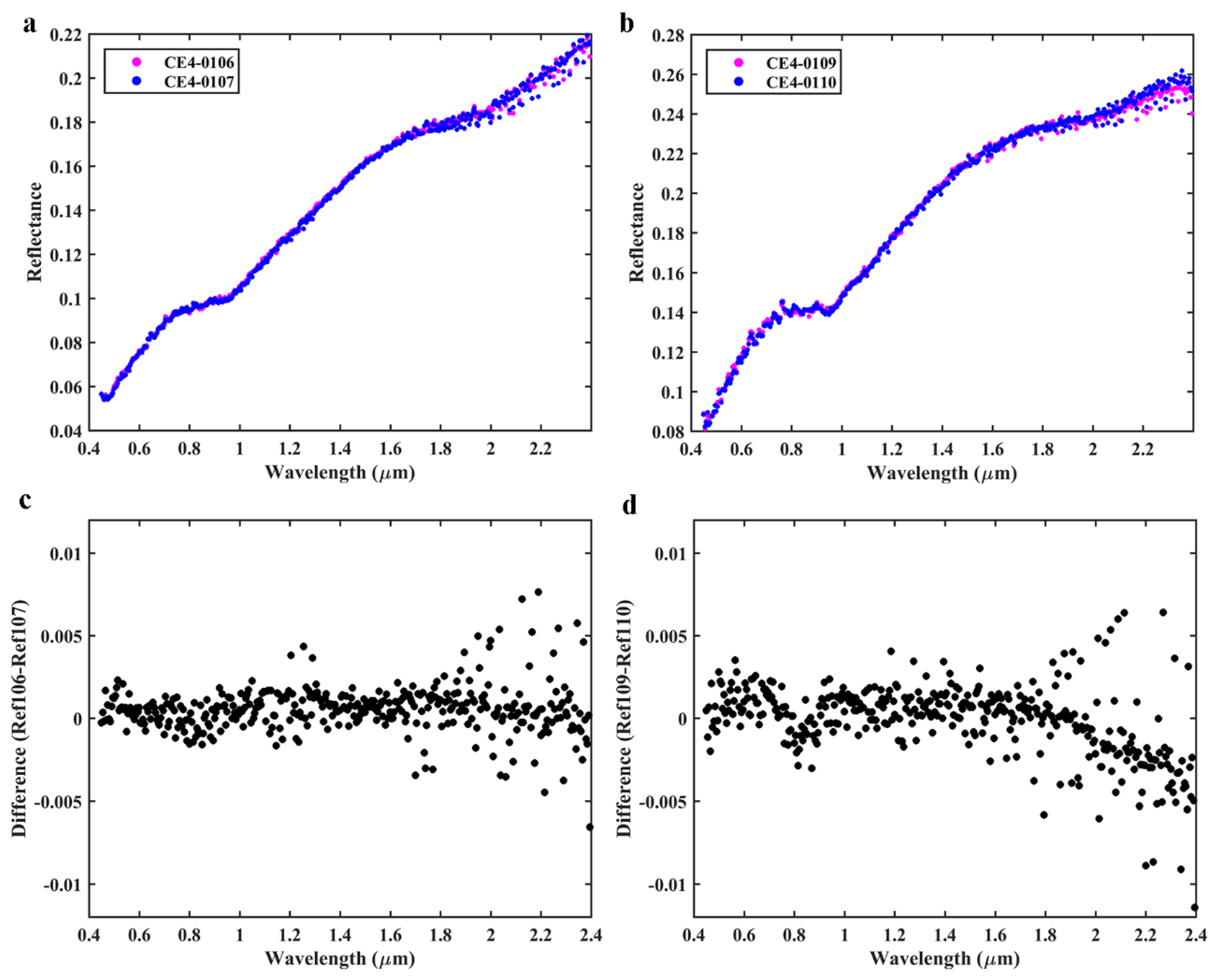
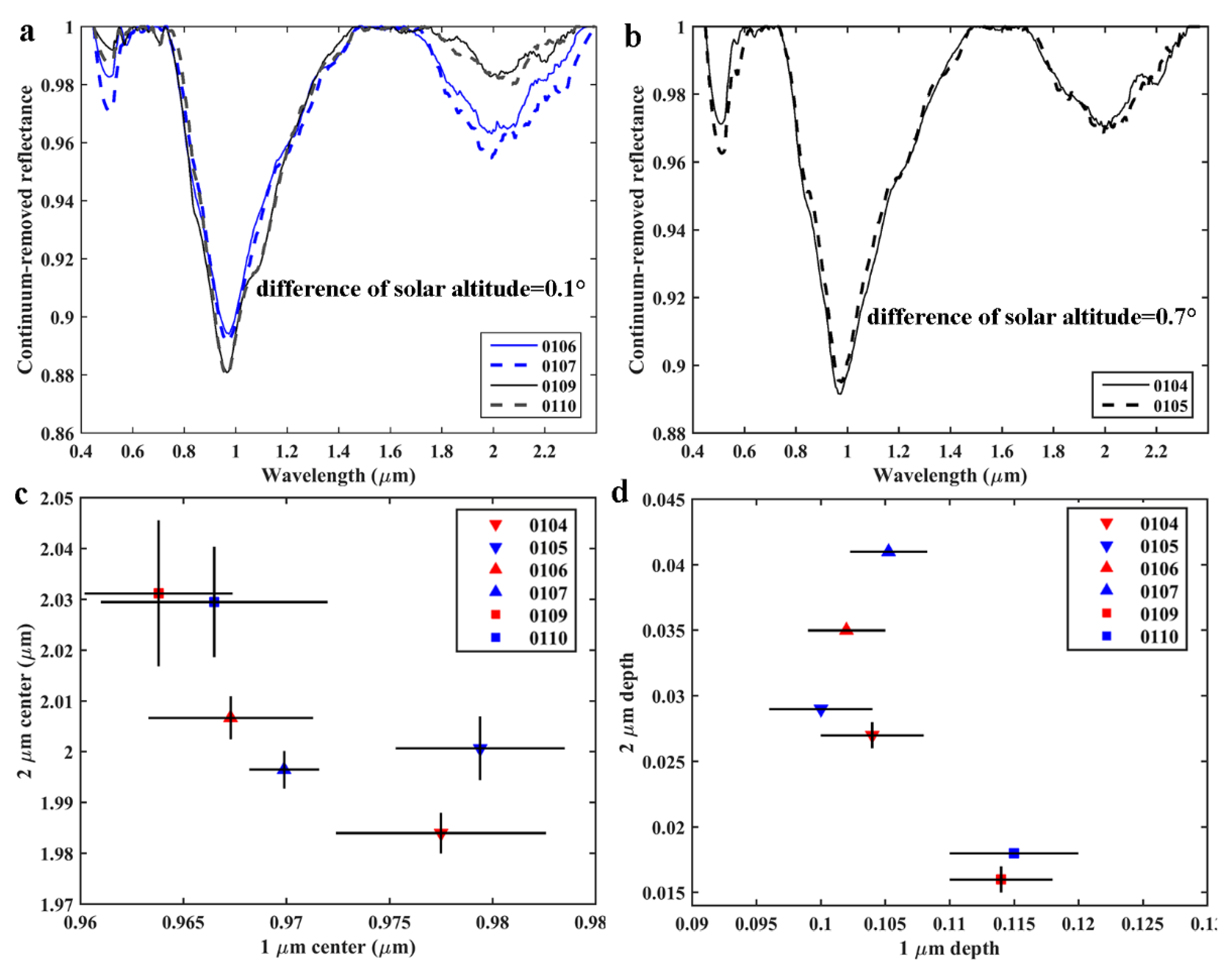
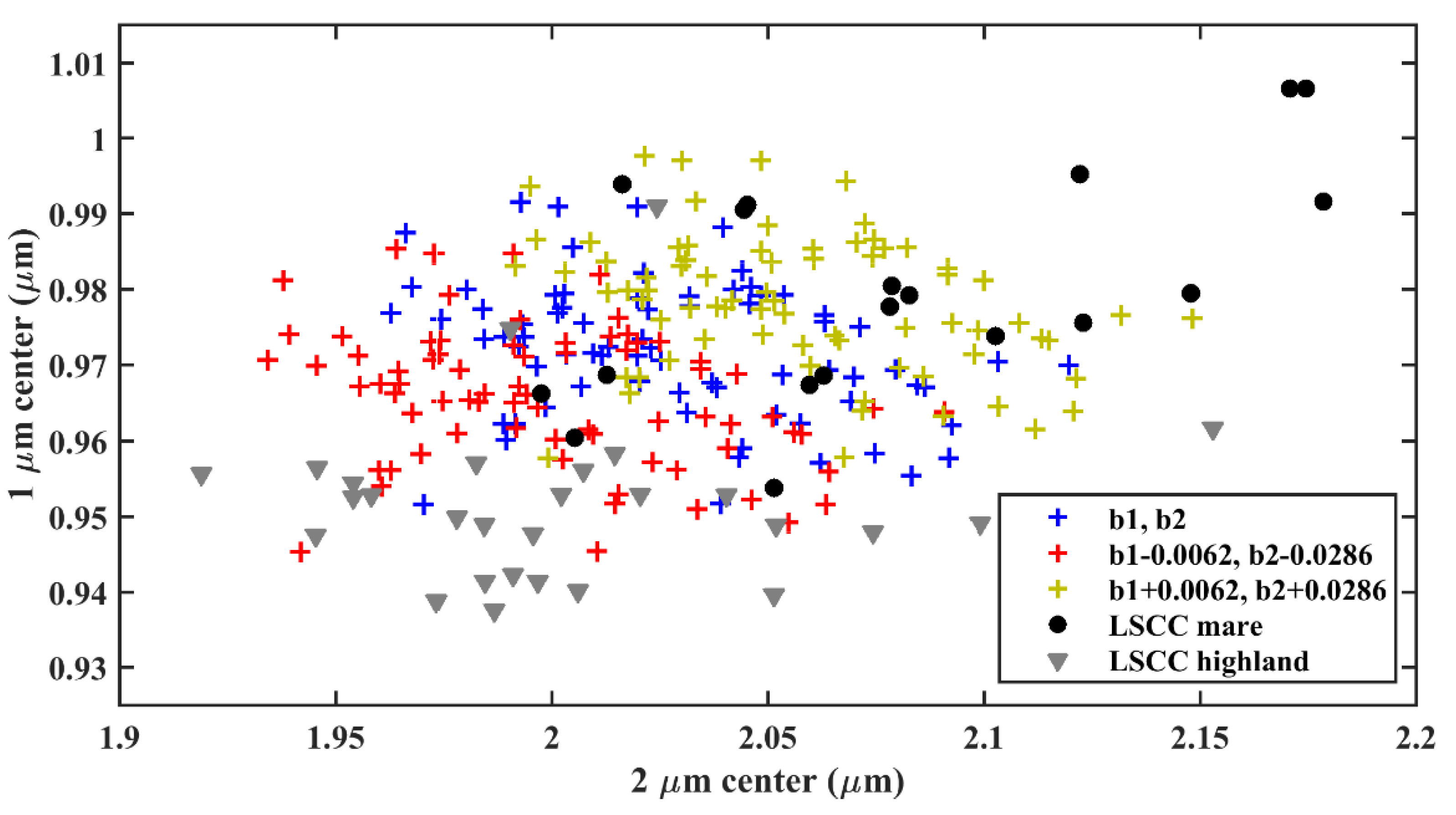
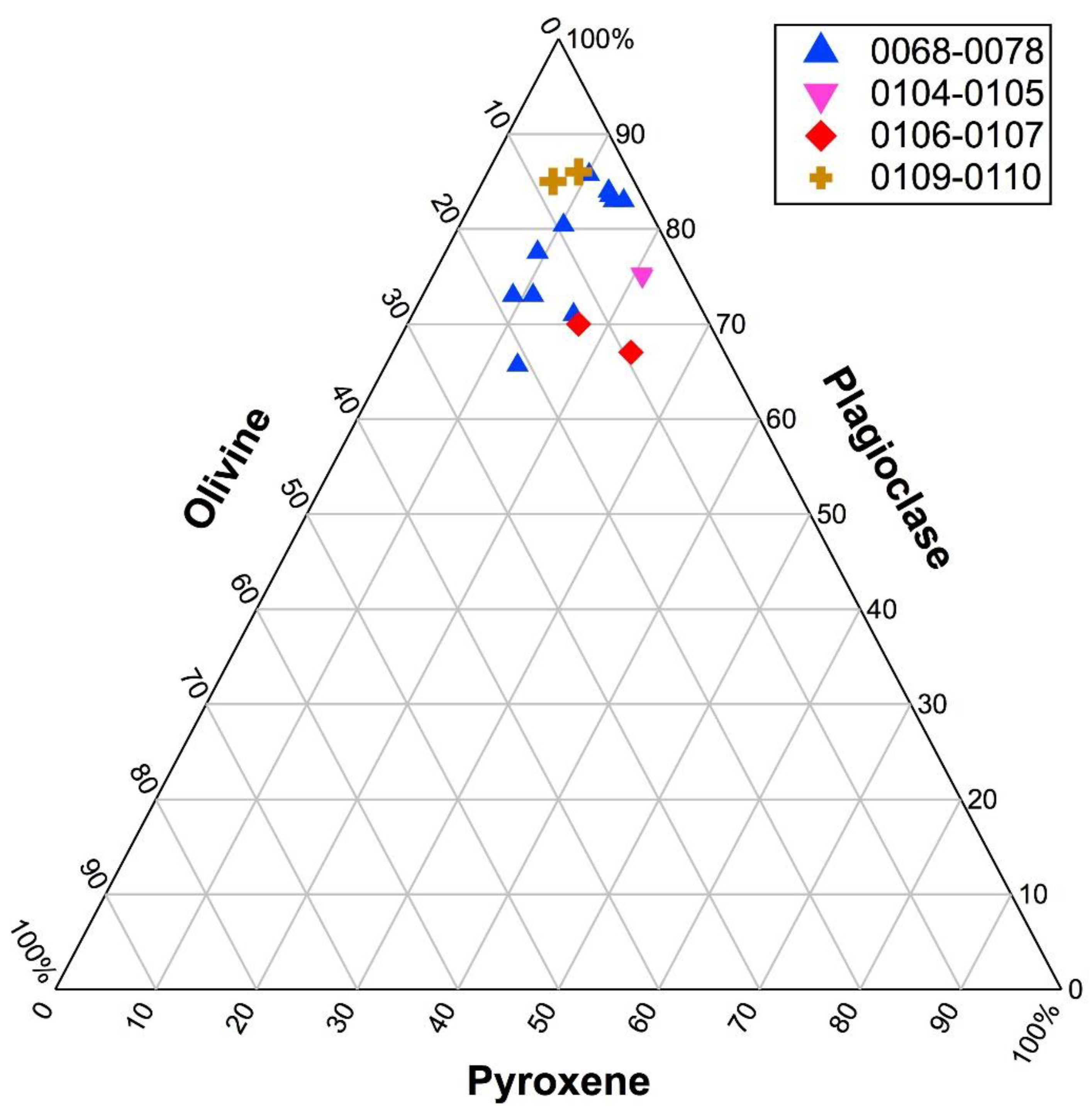
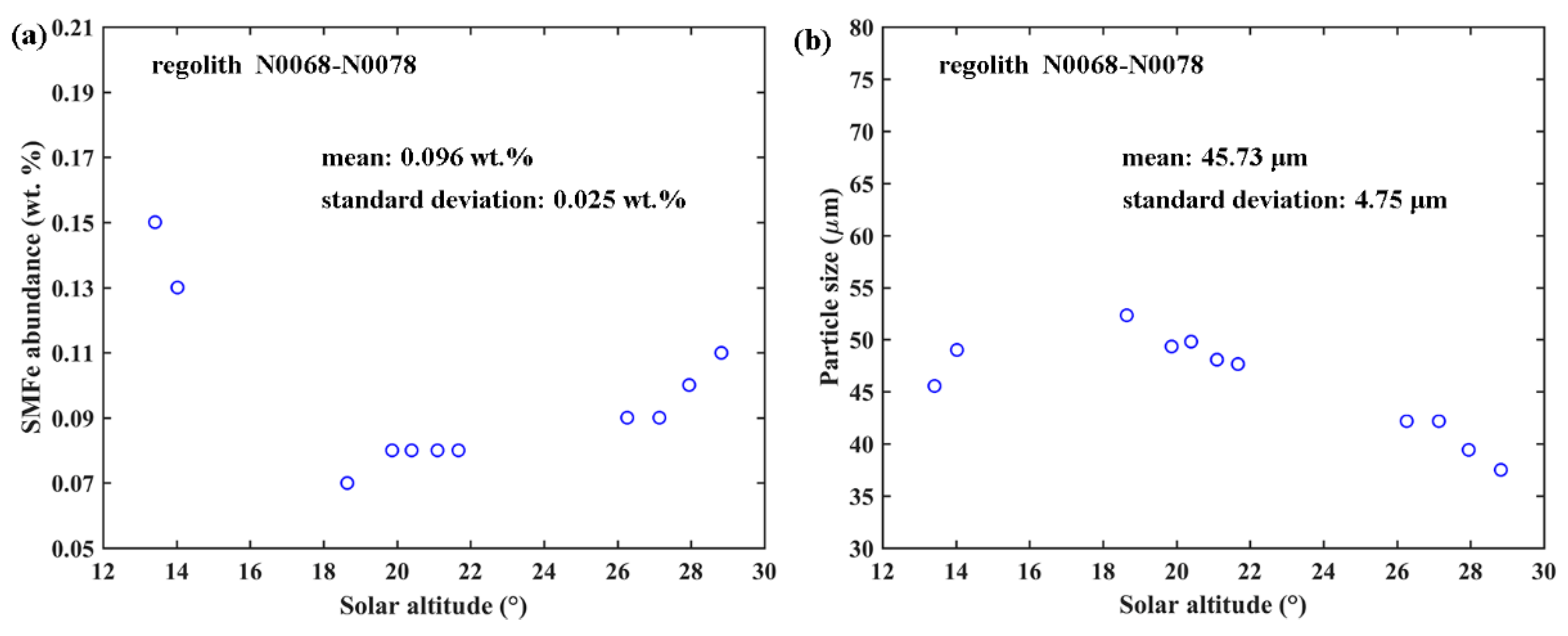
| Data ID | Incidence Angle (°) | Solar Altitude (°) | Emission Angle (°) | Phase Angle (°) | Incidence Angle Variation | Phase Angle Variation | |
|---|---|---|---|---|---|---|---|
| Figure 2a (regolith) | N0068 | 76.58 | 13.42 | 48.27 | 79.38 | ||
| N0069 | 75.98 | 14.02 | 48.27 | 78.49 | 0.60 | 0.89 | |
| N0070 | 71.36 | 18.64 | 48.27 | 71.49 | 4.62 | 7.0 | |
| N0071 | 70.14 | 19.86 | 48.27 | 69.60 | 1.22 | 1.89 | |
| N0072 | 69.61 | 20.39 | 48.27 | 68.78 | 0.53 | 0.82 | |
| N0073 | 68.90 | 21.10 | 48.27 | 67.66 | 0.71 | 1.12 | |
| N0074 | 68.33 | 21.67 | 48.27 | 66.76 | 0.57 | 0.9 | |
| N0075 | 63.74 | 26.26 | 48.27 | 59.24 | 4.59 | 7.52 | |
| N0076 | 62.86 | 27.14 | 48.27 | 57.73 | 0.88 | 1.51 | |
| N0077 | 62.05 | 27.95 | 48.27 | 56.32 | 0.81 | 1.41 | |
| N0078 | 61.18 | 28.82 | 48.27 | 54.79 | 0.87 | 1.53 | |
| Figure 2b (rock-bearing area) | N0104 | 58.83 | 31.17 | 43.23 | 49.70 | ||
| N0105 | 59.53 | 30.47 | 43.23 | 50.94 | 0.70 | 1.24 | |
| Figure 2c (rock-bearing area) | N0106 | 60.24 | 29.76 | 43.08 | 54.06 | ||
| N0107 | 60.35 | 29.65 | 43.08 | 54.26 | 0.11 | 0.20 | |
| Figure 2d (rock-bearing area) | N0109 | 67.40 | 22.60 | 42.93 | 66.76 | ||
| N0110 | 67.52 | 22.48 | 42.93 | 66.95 | 0.12 | 0.19 |
© 2020 by the authors. Licensee MDPI, Basel, Switzerland. This article is an open access article distributed under the terms and conditions of the Creative Commons Attribution (CC BY) license (http://creativecommons.org/licenses/by/4.0/).
Share and Cite
Lin, H.; Lin, Y.; Wei, Y.; Xu, R.; Liu, Y.; Yang, Y.; Hu, S.; Yang, W.; He, Z. Estimation of Noise in the In Situ Hyperspectral Data Acquired by Chang’E-4 and Its Effects on Spectral Analysis of Regolith. Remote Sens. 2020, 12, 1603. https://doi.org/10.3390/rs12101603
Lin H, Lin Y, Wei Y, Xu R, Liu Y, Yang Y, Hu S, Yang W, He Z. Estimation of Noise in the In Situ Hyperspectral Data Acquired by Chang’E-4 and Its Effects on Spectral Analysis of Regolith. Remote Sensing. 2020; 12(10):1603. https://doi.org/10.3390/rs12101603
Chicago/Turabian StyleLin, Honglei, Yangting Lin, Yong Wei, Rui Xu, Yang Liu, Yazhou Yang, Sen Hu, Wei Yang, and Zhiping He. 2020. "Estimation of Noise in the In Situ Hyperspectral Data Acquired by Chang’E-4 and Its Effects on Spectral Analysis of Regolith" Remote Sensing 12, no. 10: 1603. https://doi.org/10.3390/rs12101603
APA StyleLin, H., Lin, Y., Wei, Y., Xu, R., Liu, Y., Yang, Y., Hu, S., Yang, W., & He, Z. (2020). Estimation of Noise in the In Situ Hyperspectral Data Acquired by Chang’E-4 and Its Effects on Spectral Analysis of Regolith. Remote Sensing, 12(10), 1603. https://doi.org/10.3390/rs12101603




